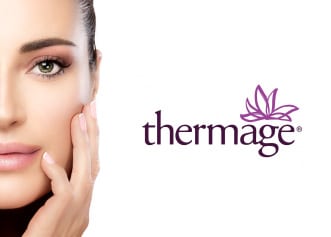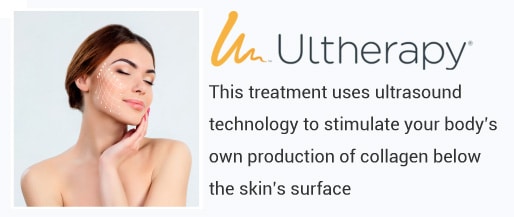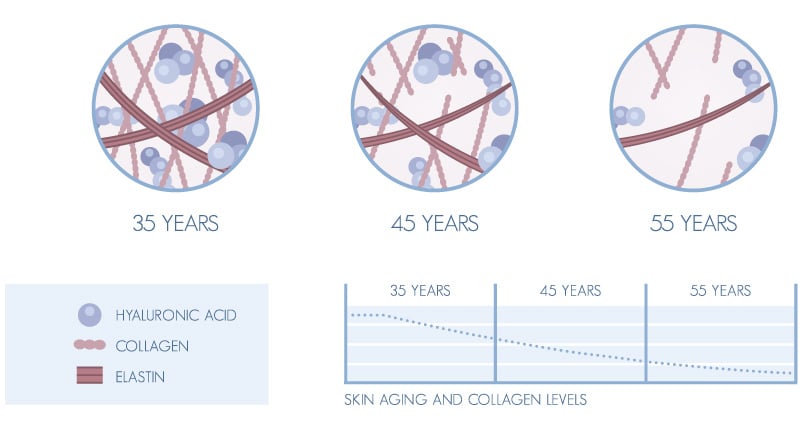Sagging skin, especially on the face and neck, can be one of the most frustrating signs of aging. Even though sagging skin is part of the normal aging process, it can be a cosmetic concern for both men and women. If you wish to tighten certain areas of loose skin, keep reading to learn exactly what causes sagging skin and what treatment options are available to achieve more firmness and less laxity.
What causes sagging skin?
Skin laxity (from the same root as “relax”) is the medical term for the acquired looser, softer, thinner skin that develops with age. Skin laxity is the result of both intrinsic and extrinsic factors that contribute to loss of collagen and elastin in the skin. Other than natural aging and genetics (intrinsic), examples of outside, or extrinsic, factors at play include diet, stress, lifestyle, sun exposure, weight fluctuations, exposure to environmental toxins, and smoking. Once these factors break down the collagen and elastin fibers that give skin its firmness and elasticity, gravity has a more visible impact on appearance.
Non-invasive treatments for sagging skin
Non-invasive treatments for sagging skin involve devices that utilize either mechanical or biochemical pathways to first cause collagen contraction and destruction, which then leads to collagen remodeling. (J Clin Aesthet Dermatol. 2010) The results of collagen remodeling is tissue tightening and improvement of the sagging skin. Below are two examples of non-invasive treatment options for sagging skin. Dr. Krant does not perform these treatments at this time, but can refer you to colleagues who do, if you decide together that these devices will be a good idea for you.
Thermage
Thermage® is an FDA-approved and clinically-proven treatment that utilizes monopolar radiofrequency energy to penetrate deep into the skin’s dermis and subcutaneous tissue, delivering an electrical current that creates heat through the inherent electrical resistance of the skin cells. The heat denatures collagen molecules by breaking hydrogen bonds in its chains, resulting in collagen thickening and remodeling. Thermage results in tighter-looking skin immediately, with little to no downtime afterwards. The result is a smoother, sleeker, and younger-looking version of yourself.
Ultherapy
Ultherapy® is a non-invasive procedure FDA-cleared to lift skin on the neck, under the chin, on the décolletage, and above the brow. This treatment uses ultrasound technology to stimulate your body’s own production of collagen below the skin’s surface. As collagen continues to increase over time, you will notice dramatic, long-lasting results that create a smoother, refreshed appearance.

Minimally invasive treatments for sagging skin
Minimally invasive treatments for sagging skin involve various types of injectable dermal fillers. Often referred to as a “liquid facelift”, dermal fillers can produce dramatic results without the side effects and costs that come with a traditional facelift. Although results from dermal fillers are temporary, the newest fillers on the market have been formulated to last as long as 18 months. In reality some last longer. Below is a brief overview of the most common types of dermal fillers that can be used to treat sagging skin.
Hyaluronic Acid
The most popular category of dermal fillers is hyaluronic acid (HA). It is a natural agent distributed widely throughout many body tissues, such as skin and cartilage. It is an anionic, non-sulfated glycosaminoglycan – in simple terms, this means it is a sugar that serves to attract and bind water molecules, thus keeping the skin hydrated as well as giving it volume. Dermal fillers that contain hyaluronic acid include Restylane®, Juvederm®, and others. Hyaluronic acid fillers can restore a more youthful appearance by filling out wrinkles and skin folds, replacing lost facial volume, with results lasting anywhere from several months to over a year. Evidence now shows that HA filler treatment does also stimulate the production of natural collagen.
Collagen
Collagen is the most abundant protein in the human body. It is the main structural protein of the extracellular space in various connective tissues, including the dermis, the middle layer of skin that lies below the epidermis. The connective tissue of the dermis provides strength and elasticity to the skin through an extracellular matrix composed of collagen and elastin fibers, which are embedded in hyaluronan and proteoglycans. The effects of collagen fillers only last for about 3 to 4 months, making them the shortest-lasting of injectable filler materials. For this reason, collagen is rarely used as a filler in the United States at this time.
Calcium hydroxylapatite
According to the American Society of Plastic Surgeons, calcium hydroxylapatite is found naturally in human bones and is a mineral-like compound, making it the heaviest of all dermal fillers. One calcium hydroxylapatite dermal filler is Radiesse, which can immediately replenish lost volume and stimulate the production of your own natural collagen with results that can last a year or more in many patients. The downside of Radiesse treatment is that it is permanent and not dissolvable. For this reason, Dr. Krant does not use Radiesse.

Invasive treatments for sagging skin
The most invasive treatment option for sagging skin is surgery. Surgical procedures relating to skin laxity range from facelifts to body contouring after weight loss to blepharoplasty (eyelid surgery) for drooping eyelids.
While surgery provides patients with a long-lasting solution to their sagging skin concerns, there are a few drawbacks to this treatment option. There are the general side effects that come with any surgery, such as bruising, bleeding, and swelling, which means that recovery from surgical procedures is longer than the aforementioned treatment options. Also, surgery comes with the risk of complications such as infections and the possibility of developing scars.
Schedule a Consultation
Sagging skin is a natural part of the aging process. External factors can contribute to sagging skin, such as too much sun exposure, weight loss, or smoking. Fortunately, many treatment options exist for sagging skin, ranging from non-invasive tightening device procedures like Thermage and Ultherapy performed by Dr. Krant’s colleagues, to minimally invasive dermal fillers and skin rejuvenation lasers performed by Dr. Krant herself, to surgical intervention such as facelifts performed by Dr. Krant’s plastic surgery colleagues.
To determine which treatment option for sagging skin is most appropriate for you, schedule a consultation with Dr. Jessica Krant to discuss your unique needs and goals.
Jessica Krant, M.D., MPH, is a board-certified dermatologist with specialized experience in cosmetic, laser, surgical, and medical dermatology, but above all, Dr. Krant is most proud to be a caring, comprehensive physician who takes the time to listen and send her patients home with a smile.















Leave A Comment